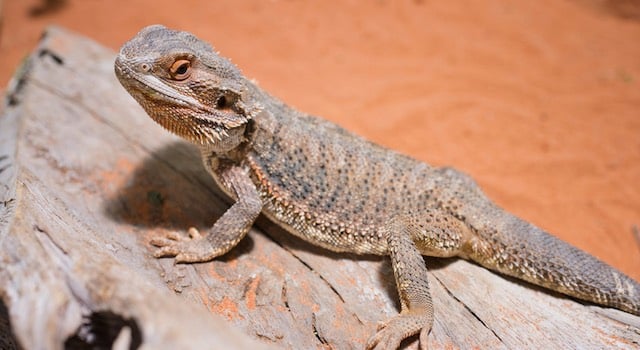
Introduction to Bearded Dragon Substrate
One of the most controversial topics among reptile keepers is the best type of bearded dragon substrate. We are big advocates of natural substrates that closely replicate their natural habitat in the Australian Outback. According to Dr. Jonathan Howard (Beardievet), the substrate in their natural environment (Australian Red Sand) comprises of 0.3% gravel, 95.9% fine sand, 1.5% silt, and 2.3% clay.
Dr. Frances Baines, a veterinarian and bearded dragon expert, advises that the most appropriate substrates for bearded dragons include blends of soil and sand or children’s play sand. She also recommends Incorporating some hard substrates, like tiles or slate, as it is easy to clean and can naturally file down their claws.
In this article, we will discuss the best and worst bearded dragon substrate and why it’s important for their health and well-being.
The Importance of Natural Bearded Dragon Substrate
Bearded dragons have adapted to the arid and rocky Australian landscape, where they commonly encounter sand, rocks, and loamy soil. These types of substrates encourage natural behaviors such as digging and burrowing, which makes it important to replicate in captivity. Natural substrates also tend to be more hygienic than other types because they absorb waste well, which can prevent harmful fungal and bacterial growth.
Natural substrates are often preferred because they can make the enclosure look more aesthetically pleasing, which is why many keepers use them to create a naturalistic setup. Furthermore, loose sandy or soil substrates are beneficial for a bearded dragon’s joints and muscles by encouraging digging.
Bearded Dragon Substrate to Avoid
Here are the main substrates to avoid using in your bearded dragon’s enclosure:
- Gravel
- Wood shavings
- Corn cob
- Walnut shells
- Cat litter
- Calcium sand
You generally want to avoid any toxic, sharp, or calcium-based substrates because they can be dangerous for your bearded dragon’s health. Gravel, walnut shells, and corn cob substrate are a serious hazard and can lead to intestinal blockages if ingested. The pieces are small enough to be easily swallowed and can be difficult to digest, so it’s best to avoid them at all costs. Plus, corn cob is known to get moldy very quickly when it becomes wet. Mold can be harmful for bearded dragons and could cause respiratory issues and other health problems.
Cedar and pine wood shavings are among the most popular small animal substrates, but they are dangerous to most reptiles. This is because they release aromatic compounds known as “phenols” that can irritate the respiratory tract and skin. Plus the sharp pieces of wood shavings can also cause skin and feet injuries.
Calcium sand is specifically made for reptiles, but there is a risk of impaction if it’s ingested in large amounts. The main additive to this type of sand is calcium carbonate, which neutralizes stomach acid and can lead to digestion issues and intestinal blockages.
Lastly, cat litter is one of the most dangerous substrates for bearded dragons. Many types of cat litter contain harmful chemicals and artificial fragrances that aren’t good for them to inhale or ingest. Cat litter also clumps when it becomes wet, which is a problem if it gets ingested because it can cause gut impaction.
Recommended Bearded Dragon Substrate
So, what types of substrates are recommended for bearded dragons?
Desert Sand
Desert sand closely resembles the type of substrate bearded dragons use for digging and burrowing in their wild habitat. It’s a natural, loose substrate that is calcium-free and, therefore, has a very low to no risk of gut impaction. It holds burrows very well and is easy for bearded dragons to dig through like they would in the wild. Many keepers prefer using desert sand because it makes the enclosure look realistic and creates a natural environment in which bearded dragons thrive. It’s also absorbent and retains heat well, so it creates a warm and comfortable environment.
Some recommended options include:
Blends of Soil and Sand
Many keepers recommend blending a mix of soil and sand together to create the perfect texture for burrowing, digging, and absorbency. You can DIY a natural substrate mix using 50% fine quartz sand, 30% organic topsoil, and 20% Zoo Med excavator clay. Fine quartz sand and organic topsoil are ideal for burrowing and digging, while excavator clays retain heat better and can help to hold the burrow’s shape. It also creates a firmer ground for bearded dragons to walk over than fine sand or soil.
Dried-Out Children’s Play Sand
A more affordable alternative to reptile substrates is children’s play sand, which can be found at most hardware stores. Unlike reptile sands and soil that are safe to use right away, play sand must be dried out and sanitized before it is safe to use in your bearded dragon enclosure.
There are several methods you can use to dry it, but baking it in an oven on high heat is the quickest and most effective way. To do this, you can place a layer of play sand in a deep baking tray and bake it for about 20-30 minutes at 350°F. This process also kills any bacteria, mold, and parasites that might have been lurking in the moist sand.
Make sure you choose fine-textured play sand that is free from calcium, harmful chemicals, fragrances, and dyes to keep your bearded dragon safe.
Bioactive Substrate
A bioactive substrate is used in bioactive enclosures, which simply refers to a captive environment that closely replicates a reptile’s wild habitat. It’s a type of self-sustaining ecosystem composed of natural substrates and enrichment items like rocks, branches, and live plants. The substrate plays a major role in creating the perfect bioactive enclosure. Generally, a mix of fine sand, loose topsoil, excavator clay, and leaf litter is used to create bioactive substrates. To make it truly “bioactive,” natural organisms like arid springtails and isopods are added to make the substrate functional. They help to prevent harmful mold and bacterial growth by breaking down waste and keeping the substrate aerated.
Incorporating Hard Surfaces in the Vivarium
You can use several different substrate textures to create an ideal environment for your bearded dragon. Although loose substrates are great for digging and burrowing, hard surfaces such as tile or slate. Tiles made from stone, ceramic, or porcelain are a common type of hard substrate that is affordable and easy to maintain.
Hard surfaces are more hygienic than loose substrates because they can be cleaned easily. They are also comfortable for bearded dragons to walk on and do not have an impaction risk because they cannot be ingested. That’s why many keepers prefer to use hard surfaces in the areas where their bearded dragon commonly eats.
Bearded Dragon Substrate and Health: The Role of Lighting and Calcium
Gut impaction occurs when a bearded dragon’s digestive tract becomes blocked to the point that food and waste cannot pass through. This can happen for several reasons, but undigested food and substrate are common causes. It’s common for bearded dragons to ingest small amounts of substrate while they are eating, and it usually doesn’t cause any issues. However, certain types of substrates, such as gravel, corn cob, walnut shells, and calcium sands, are difficult to digest and can become lodged in the digestive tract. This increases the risk of impaction, hence why those types of substrates should be avoided.
Regardless, a healthy digestive system is important in lowering the risk of gut impact impaction because it ensures any ingested food and substrate can be broken down and expelled effectively. It also encourages healthy bowel movements, which prevents food and substrates from accumulating in the gut.
A balanced diet and proper heat and UVB exposure are crucial for maintaining a healthy digestive system. Bearded dragons need essential vitamins and minerals to support a healthy digestive system, which they should get from a balanced diet. Calcium and vitamin D3 supplements not only help prevent metabolic bone disease but also support muscle function, including the ones involved with digestion. Their diet should be supplemented with calcium and dietary vitamin D3, along with exposure to UVB lighting, to aid in proper calcium absorption.
Furthermore, bearded dragons are ectothermic (cold-blooded) and need external heat to prevent digestive issues. Warm temperatures aid in the breakdown of food and keep their metabolism functioning properly. You should always make sure that your bearded dragon has access to a basking light for warmth and that the enclosure is kept within an ideal temperature range to support proper digestion.
Conclusion
Substrate is important for bearded dragons’ health, comfort, and well-being. There are numerous types of bearded dragon substrate to choose from, but some of the best options include loose sandy substrates like desert sand and soil, along with hard surfaces such as stone or ceramic tiles. Understanding the benefits and risks of each substrate is important and will help you choose the right type to support their long-term health. The main goal is to create a naturalist enclosure that closely replicates their wild Australian habitat while minimizing potential health hazards like gut impaction or toxicity.



